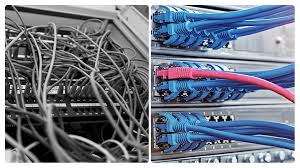Setting up a network infrastructure might sound a little overwhelming at first. But trust me, it’s not as scary as it sounds. Whether you’re doing it for your home or office, knowing the basics can save you from a lot of future headaches. In this post, we’ll break it all down. We’ll cover everything you need to know before you install your network. Let’s jump in!
Why a Strong Network is Essential
Picture your network as the heart of your home or office. It keeps everything running smoothly. If it’s weak, everything suffers — slow internet, constant disconnections, or worse, no connection at all. We all rely on our networks for work, fun, and everything in between. So, if your network setup isn’t up to par, you’ll run into problems fast.
One big part of a solid network is your network cabling. A good connection between devices is critical, and the right cables make sure everything stays in sync. If you get your cabling wrong, you could end up with frustrating delays or, worse, no connection. Let’s avoid that, right?
The Core Components You’ll Need
Now that we know why it’s important, let’s look at what you’ll need to set up your network. Here’s a quick breakdown of the main components:
1. Cables
Cables are the lifeblood of your network. They connect everything. You’ll mostly be using Ethernet cables, but some setups may also require fiber optic cables. It all depends on your needs. Think about how many devices you’ll connect and how fast you need the network to be. Go for Cat5e or Cat6 cables for a good balance of speed and cost.
2. Router and Switches

The router is your connection to the internet. It’s like the boss of your network. It sends data to all the connected devices. Switches are also important. They help you connect multiple devices to the network. Without a good switch, you’ll be left with a slow, congested system.
3. Access Points and Modems
Access points expand the network’s reach, especially for wireless connections. If you’ve got a large home or office, this is a game-changer. And the modem? Well, that’s what connects your network to the internet. It’s usually supplied by your internet provider.
4. Patch Panels and Racks
If you’re setting up a larger network, patch panels and racks come in handy. These tools help you keep everything neat and organized. A patch panel is where all your cables come together, and a rack holds your hardware in place.
What to Consider Before Installing
Before you start the installation, there are a few things to think about. Trust me, a little planning now will save you a lot of trouble later. Here are some key things to consider:
1. Size of Your Space
First things first — how big is the space you’re wiring up? Is it a small room or an entire office? The size of your space determines how much cabling you’ll need and where you’ll place your devices. You’ll also need to consider the range of your Wi-Fi. Make sure your router or access points cover all the areas you’ll be using.
2. Bandwidth Needs
What will you use your network for? Will you mostly browse the web or stream videos? The more you use the internet, the more bandwidth you’ll need. Gaming, for example, needs a stable and fast connection. So, make sure your setup can handle what you plan to do.
3. Future Growth
It’s always a good idea to think ahead. Will your network need to support more devices in the future? Planning for future growth can save you the hassle of upgrading later. You don’t want to outgrow your network too quickly, do you?
4. Security
We all know how important online security is. When setting up your network, make sure you secure it. Use firewalls, encryption, and strong passwords to keep your data safe. You don’t want to leave your network vulnerable to attacks.
5. Professional Help
If you’re not super comfortable doing this on your own, it might be a good idea to call in a pro. A technician can set everything up for you, ensuring everything works perfectly. And don’t forget — your internet provider, like Comcast Service, might offer assistance too.
Planning Your Network Installation

Once you’ve figured out what you need, it’s time to plan. Here’s how to go about it:
1. Draw a Map
Before you start installing, draw a simple network map. It’ll show where your router, switches, and access points go. It’s a great way to make sure you’ve thought of everything. Plus, it’ll keep things organized while you work.
2. Choose the Right Cables
Not all cables are created equal. For most setups, Cat5e or Cat6 Ethernet cables will do the job. They’re affordable and reliable. But if you need faster speeds or longer distances, go for fiber optic cables.
3. Install the Hardware
Next, get your hands dirty! Install your router first, then hook up your switches, access points, and any other devices. If you’re using a patch panel, organize your cables neatly. Keep everything secure and easy to access.
4. Run the Cables
Now it’s time to lay down your cables. Run them along the walls or ceiling to keep everything neat. Don’t forget to use cable ties or clips to avoid tangling. A clean setup looks better and works more efficiently.
5. Test Your Network
Once you’ve connected everything, test it out. Check that all your devices connect properly. Run a speed test to make sure your network is working as expected. If something doesn’t work, check the cables or reset your router. Sometimes, that’s all it takes to fix the issue.
Troubleshooting Common Problems
Even with the best planning, things can go wrong. Don’t worry, though — here are some common problems and how to fix them:
1. Slow Internet Speed
If your internet is slow, it could be because your router is too far from your devices. Try moving the router to a central location or adding an access point. If that doesn’t work, check your cables. Faulty cables can slow things down.
2. Wireless Interference
Wireless signals can be affected by things like microwaves or other electronics. Try changing your router’s Wi-Fi channel or moving your router away from these devices. That should help reduce interference.
3. Device Connection Issues
If your devices aren’t connecting, make sure they’re in range of your router or access point. Restart the device or router to see if that helps. Simple, but effective.
Final Thoughts
Installing a network infrastructure isn’t as difficult as it may seem. With the right preparation and a little elbow grease, you can set up a reliable network that keeps everything running smoothly. Plan, choose the right equipment, and don’t forget about security. If you run into trouble, there are always pros and tech support (like Comcast Service) to help out.
Once your network is up and running, you’ll enjoy a faster, more reliable connection. So go ahead, get started, and set up your network the right way. You’ve got this!


